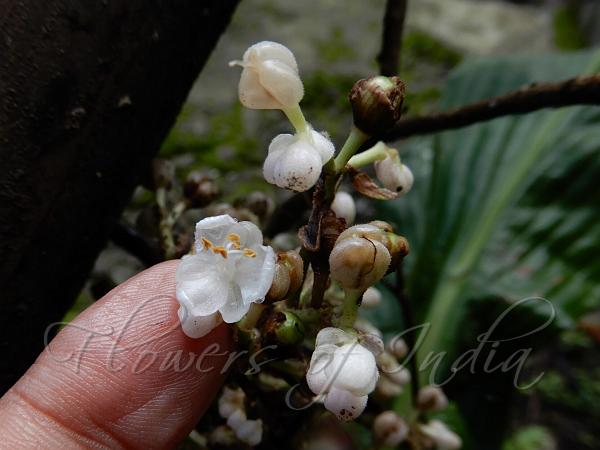|
| East-Indian Pollia |
|

|

| File size | 301040 |
| Original date | 6/21/22 12:36 PM |
| Resolution | 3648 x 2736 |
| Flash | Flash did not fire, auto |
| Focal length | 4.3mm |
| Exposure time | 1/200s |
| Aperture | 3.4 |
| Focus Distance | |
| Metering Mode | Center weighted average |
| Camera make | NIKON |
| Camera model | COOLPIX A900 |
| Sensor type |
|
|
|
|
Photo: |
Botanical name: Pollia hasskarlii Family: Commelinaceae (Dayflower family)
Synonyms: Pollia aclisia var. robusta
Synonyms: Pollia aclisia var. robusta
East-Indian Pollia is a perennial herb with stems
ascending, up to 1 m x 1 cm, hairless. It has been named in honor of
Justus Karl Hasskarl (1811-1894), German-born Dutch botanist. Leaves
are stalkless or base narrowed into a short leaf-stalk; leaf sheath 3-5
cm, hairless. Leaves are elliptic or obovate-inverted-lanceshaped,
15-35 x 4-9 cm, hairless on both surfaces. Flower-clusters are usually
shorter than distal leaves; flower-cluster-stalk 5-10 cm, densely
whitish glandular; cincinni numerous, about 2 cm, usually not in
whorls, densely whitish glandular; involucral bracts about 10 mm,
densely whitish glandular, falling off; bracts membranous. Sepals are
nearly ovate, shallowly boat-shaped, 3-4 mm, below finely velvet-hairy
glandular, falling off. Petals are white or pale purple, obovate, about
5 mm. Stamens are 6, all fertile. Fruits are spherical, 4-5 mm in
diameter. East-Indian Pollia is found in Shaded places in ravines or
dense forests, near sea level to 1700 m, in China, Bhutan, E India,
Laos, Myanmar, Thailand, Vietnam. Flowering: March-June.
| Identification credit: M. Sawmliana | Photographed in Leimaram, Manipur & Tamdil, Mizoram. |
• Is this flower misidentified? If yes,